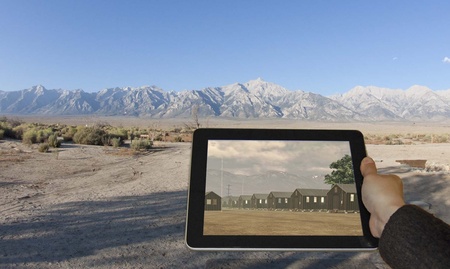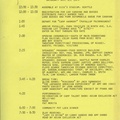4. Pain for Children
The impact of the internment experience on each child is different, but it seems to vary greatly depending on age, living environment up until that point, whether or not they had a support group, the mental stability of their parents, etc. Since they were put in the internment camps simply because they were Japanese-American, they ended up feeling ashamed of being Japanese-American and guilty about being Japanese-American.
However, many who spent their childhood in the camps say, "It was fun," and "I enjoyed playing baseball all day." Their parents protected them, and it seems that children have the strength to survive strong anywhere, as long as they have people who love them. Bacon also said, "For teenagers like us, life in the camp was fun. We were surrounded by Japanese people, so we made lots of friends. Before the camps, we lived on farms, so our homes were far apart and it wasn't an environment where we could easily find friends to play baseball with, but at Heart Mountain we were able to play baseball, football, and go hiking right away. Even though we didn't have money or material things, we could play all kinds of games and it was a lot of fun. But I'm not saying that life in the camps was good for the children, I'm just saying that we accepted the unjust situation and made the best of it." 1
On the other hand, there are still people who hesitate to talk about those times. I have met people who were raised by their Issei parents to tell them, "Men should not cry," so they cannot cry even if they want to. No matter who I talk to, they always end up expressing their gratitude to their parents. The greatest pain for children may be the hardships their parents' generation experienced. I pray that those who are still suffering will be able to return to peaceful days as soon as possible.
5. Connecting to the future
What happened to Japanese Americans during the war could easily happen to anyone. Shortly after 9/11, America came close to repeating the same mistake. What stopped it was then-Secretary of Transportation Norman Mineta, who spent his childhood in Heart Mountain. Mineta condemned racism against Arab Americans and Muslims and rejected pressure to segregate them.
"Since its founding, the United States has treated some people with equality, but equality for all is the goal. To achieve this ideal, we need at least some understanding of others. As a nation, we must be careful not to let prejudice and preconceived ideas drive our actions. In the last half century, the door to equality has opened, but the road to equal treatment for all is a long one, but I hope it is achievable. It is important not only to know why the exclusion and internment suffered by Japanese Americans during the war occurred, but also how such a terrible policy was pursued. To understand this process requires insight into the path by which a nation embarked on such a large-scale program of injustice. Only by making every American citizen understand this will we ensure that such injustice never happens again to another American citizen," Kashima writes in his book Judgment without Trial . 2
We will introduce a few attempts to connect the American stories of what happened to Japanese Americans to the future.
Letter to Ms. Breed - Japanese American National Museum
In 1988, Breed, now 82 years old, was preparing to sell the home she had lived in for many years and move to a nursing home when she came across a box she had treasured. Inside were letters of thanks from children who had sent Breed books to encourage them. Feeling nostalgic, she sat down and thought of each child's face. However, she could not bring the letters into the nursing home, which had limited storage space. Breed decided to entrust them to Elizabeth, one of "Mr. Breed's children." Elizabeth took responsibility for the letters, and donated them to the Japanese American National Museum in Los Angeles. Volunteers digitized each letter, and the letters from the children can now be viewed from anywhere in the world using a computer. 3
Densho (Tradition)
A while ago, I wrote about how Peter Irons discovered the fact that the Department of Justice had concealed important documents that would have influenced the Supreme Court decision against Gordon Hirabayashi. Densho has an interview with Professor Irons himself talking about how he found out and how he felt at the time. What you read in a history book can now be heard directly, on the spot, and you can see the person's face, no matter where you are in the world. This is something that only Densho can do.
Densho is working to improve the materials and interviews on its website and to make them easier to search, while also focusing on workshops for teachers who work with children. Over the past two years, the organization has held workshops not only in the United States, but also in Japan, Canada, and the United Kingdom, so some of you may have participated in one of these workshops in Japan.
What's interesting is that the photos and materials provided are digitized and stored online by Densho, and the actual items are returned to the donors. This is a new approach to the museum, as it does not have any tangible exhibits.
CyArk
Here, I'm standing at the Manzanar site, looking at an iPad displaying an image of the site, complete with a digitally recreated barracks, created by CyArk to demonstrate the potential of a virtual tour of the Manzanar National Internment Site.

CyArk was founded in 2003 as an international non-profit organization, inspired by the destruction of the Bamiyan Buddhas by the Taliban in Afghanistan in 2001, with the aim of using new technology to create a free, 3D online library of other world cultural heritage sites before they are lost to natural disasters, destroyed by human aggression, or devastated by the passage of time. We want to share these sites with people all over the world and weave the unique stories of each of our shared human heritage in new and fascinating ways.
The Japanese American Internment Camp Project was undertaken with the hope of helping the public understand this dark period in American history and ensuring that the human rights guaranteed by law are never again violated. Manzanar, Topaz, and Tule Lake have all been completed. 5
epilogue
Now, as I finish this series, I think of the noble and strong spirit of the Issei and Nisei, and the power of individuals who put into action what they could think and do in their own circumstances. People like Clara Breed, who continued to encourage the children by sending them books, Walt Woodward, who wrote a letter to a novice reporter who wanted to quit telling her not to do so, the sister teachers who continued to transport salami and the school, the grandfather who continued to make geta sandals for fellow Japanese who were struggling in the mud, Mrs. Pollack, who gave Henry and the others the task of freely imagining their future environments, and the people who built libraries from nothing...people like these remain in my mind. What a relief it was for the children to have people like this by their side.
On a day lit by soft spring sunlight, I heard that the book that had been returned from Minidoka was in the library of the Wing Luke Museum, so I went there. While I was reading the newspaper there, I came across the words of an 80-year-old Japanese-American woman who, in gratitude for the library service she received at the "assembly center" in Portland half a century ago, anonymously donated $10,000 (1 million yen) to the Multnomah County Library Foundation. I suddenly felt like I had met the old woman I had been searching for.
It must not have been easy to deliver books to the camps at a time when there was a lot of hatred towards Japanese and Japanese-Americans. But thanks to the books and the thoughtful librarians who continued to deliver them, we were able to get through those difficult times.
(End)
Notes:
1. Sakatani, Harumi Bacon, personal communication, March 10, 2014.
2. Kashima, Tetsuden. Judgment without Trial: Japanese American Imprisonment during World War II. Seattle: University of Washington Press, 2003.
3. Joanne Oppenheim, translated by Ryo Imamura, "Dear Breed" Kashiwa Shobo, 2008
4. Tom Ikeda, personal communication, March 11, 2014. Densho.
Densho e-news, March 2014.
5. Devon Haynes, personal communication, March 12, 2014. CyArk.
6. Rubenstein, Sura. (1998, January 26). Gift thanks county library for war relief . The Oregonian.
Wertheimer, Andrew B. Japanese American Community Libraries in America's Concentration Camps. 1942 – 1946. [Doctoral dissertation] Madison: University of Wisconsin-Madison. 2004.
*Reprinted from the 137th issue (April 2014) of “Children and Books,” a quarterly magazine published by the Children’s Library Association.
© 2014 Yuri Brockett






